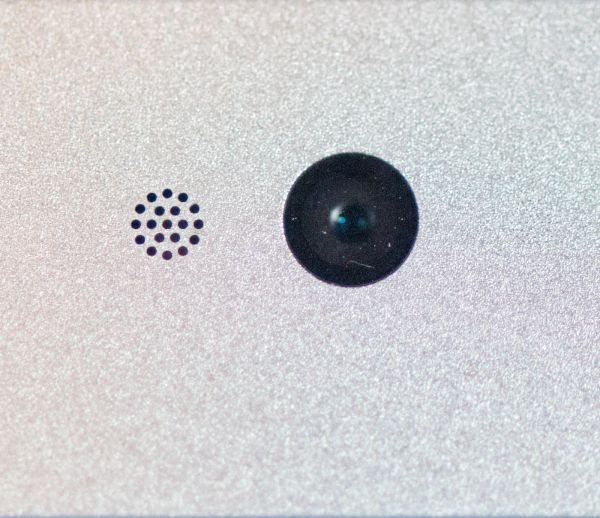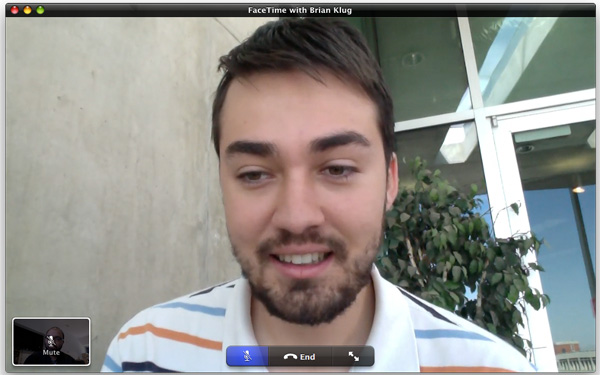The MacBook Pro Review (13 & 15-inch): 2011 Brings Sandy Bridge
by Anand Lal Shimpi, Brian Klug & Vivek Gowri on March 10, 2011 4:17 PM EST- Posted in
- Laptops
- Mac
- Apple
- Intel
- MacBook Pro
- Sandy Bridge
FaceTime HD Cameras
One of the more subtle changes between the 2010 and 2011 MBPs (and other MacBooks) is the departure from strictly VGA "iSight" cameras. The new FaceTime HD cameras are 1280x720, though Photo Booth oddly still only captures at just VGA.
A quick run to the command line and use of isightcapture enables true native resolution capture at 1280x720 until Photo Booth gets updated (if ever). I propped a 2011, 2010, and 2006 MBP up inside my lightbox and setup the scene I usually use for smartphones, and tossed in a GMB color checker card. I took photos from the command line at full resolution with no compression with both tons of light from a huge CCFL, and again with very little light. You can immediately see how things have changed if you check out the gallery with those uncompressed photos at native resolution.
The 2011 MBP's optical system achieves almost the exact same magnification (eg the height of the test objects remains the same if you scale vertical resolution) as the 2010 model. You just get a wider image at higher resolution. It isn't perfect, and even with gobs of light there's noise visible, but the quality is dramatically better. White balance is changed, with the old 2010 model having a slightly reddish cast. The difference is easily discernible in the color checker card. The old model also had less than perfect exposure (the light part at the right of the cup is completely saturated) compared to the new. Dark performance is also slightly better, again with a different color cast.
Visually, I was hard pressed to notice anything different between the two cameras on the outside. The older 2010 MBP seems to have a larger aperture, subjectively, which seems the opposite of how I'd expect things to go.


Left: 2010 MBP, Right: 2011 MBP
The other part of the story is of course FaceTime HD itself, which ups the quality of FaceTime sent from the 2011 MBP from 320x240 to 720P. While the new MacBook Pros ship with FaceTime preinstalled, older Macs need to purchase it from the App Store for $0.99. FaceTime HD leverages Sandy Bridge's Quick Sync for encoding 720P, although as we pointed out earlier—CPU utilization is still quite high. While only 2011 MBPs can send HD FaceTime, there are also restrictions on what Macs have enough processing power to decode it.

FaceTime HD works pretty well. The application starts in a small portrait window but is both scalable and viewable in landscape as well.
There's no support for text communication during a FaceTime HD chat, just video. The video quality scales dynamically with available bandwidth. FaceTime HD worked over a 512Kbps upstream connection but had reduced quality compared to transmitting over a 2Mbps connection.


















198 Comments
View All Comments
Pandamonium - Thursday, March 10, 2011 - link
I own a 15" 2010 MBP and like the author(s) of "The Big Picture" section, I like using separate peripherals at home. I don't want to come off like I'm giving a sales pitch, but after a long wait, I bought a Henge Dock for my MBP. It's a $70 plastic mold whose only purpose is to hold your cables in place so you can easily/quickly "dock" a MBP.For security concerns, I made an encrypted volume with OS X's disk utility and keep my frequently accessed sensitive stuff there. Everything else sits on my NAS.
I control heat and noise with SMC Fan Control. I've got a profile to keep "docked" fan speeds just a notch faster than default (the fan speed ramping up and down irritates me more than the absolute noise of the fan), and another profile for "lap use" to keep the machine at a comfortable temperature.
I too think that Thunderbolt is a big step towards an Apple docking station, but for now, the Hengedock, a NAS, and SMC Fan Control give me a solution that while not as elegant, is 95% of the way there.
Pandamonium - Thursday, March 10, 2011 - link
I should add that I use a Synology DS 209. If I could do it all over again, I'd go with QNAP. See my comments on Ganesh's Synology review for my reasoning. Cliffnotes are that I believe that regular SMART tests (to detect bit rot) should be part of a NAS's software stack and Synology's PR begs to differ. I'd love for Anand to offer clear advice one way or the other.dagamer34 - Thursday, March 10, 2011 - link
Does high amounts of heat ever mess up the screen or affect the dissipation of heat? I'd get worried if I were running a render or playing a game that caused my MBP to hit higher than the 80C it does now and the laptop just shuts itself down because it's too hot.dagamer34 - Thursday, March 10, 2011 - link
Based on this review and using a 17" MacBook Pro (2011), here's my advice:13" MacBook Pro - the changes from the 2010->2011 are good if you do CPU tasks, but mediocre to lame for GPU tasks. If you want to game, I'd wait until Ivy Bridge with a better GPU. Hopefully, we'll also see something more radical with ditching the optical drive allowing for a larger battery and dedicated GPU, but we'll see how that turns out.
Base 15" MacBook Pro - very good if you have CPU driven tasks, and what I'd recommend for most people. The only offsetting thing I see is that the next step up has a CPU, GPU, and VRAM bump, which may be very enticing for gamers.
High-end 15" MacBook Pro - for gamers, with the most optimal CPU, GPU, and VRAM configuration there is while still being very portable.
17" MacBook Pro - you love high-resolution screens for your work but still need to be portable. Very ideal because of the ability to have a full 1080p picture on the screen untouched for editing websites and such. Also good for photoshop. Likely for people that feel having an additional monitor is too much work, or their second monitor should be comparable in screen resolution to their main one.
I do hope the 2012 MacBook Pros cut away a lot of the fat: optical drive, FireWire port, USB port, ExpressCard slot and just have most of that functionality replicated with ThunderBolt. I feel like they could have gotten away with it this time, but there were no peripheral style docks ready, which is rather disappointing.
Ushio01 - Thursday, March 10, 2011 - link
Optical drives are still essential for those of us in the majority of the world who's internet is useless not to mention you never know if throttling or low data caps will be introduced in area's with currently good internet access subsequently making the loss of an optical drive a drawback.Also interesting phrase cutting the fat or in other word's continue paying for a premium product but get even less for your money, yay.
dagamer34 - Thursday, March 10, 2011 - link
That's what the $79 External SuperDrive is for.Ushio01 - Thursday, March 10, 2011 - link
Yay pay $1200+ for a laptop then pay $80 for the ability to use anything on it.khimera2000 - Friday, March 11, 2011 - link
Its apple your paying out of the @$$ any how. If you where going for a budget, or "price VS performance" you would not be considering an apple. I think people looking at these will have 80 bucks to spare... at least be able to scrounge up 80 bucks when the need arives.mianmian - Thursday, March 10, 2011 - link
Yeh. Apple should have the upgrade option to replace optic drive to1. a 2.5" drive slot
2. an extened battery.
gstrickler - Thursday, March 10, 2011 - link
I doubt you'll see either from Apple, however:For #1, an OptiBay from MCE (MCEtech.com), or a DataDoubler from OWC (macsales.com). The MCE offers an external USB case for the removed SuperDrive so you still have the use of the SuperDrive, and it's USB powered so it's still portable.
For #2, HyperMac (hypershop.com) sells external portable batteries for the MB/MBP.